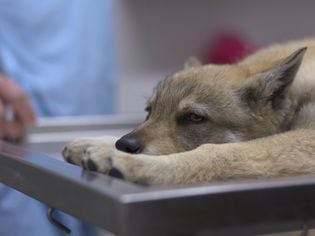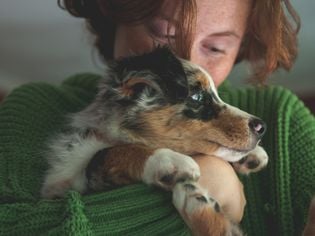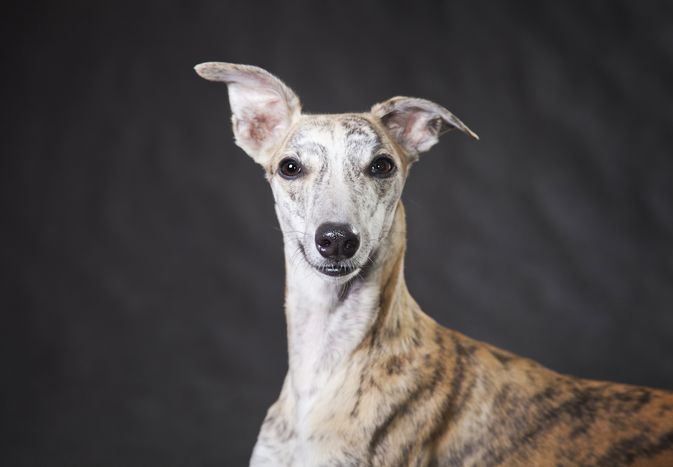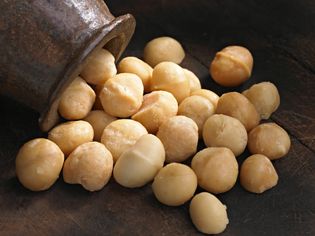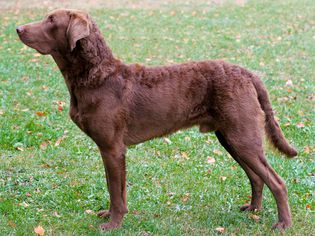The Finnish spitz is a medium-sized, non-sporting dog breed from Finland with a double coat, pointed ears, and a signature spitz tail that curls upward over its back. Affectionately called "Finkies," these dogs are animated, intelligent, and friendly. They make great additions to active families, as they're energetic, kid-friendly, and protective of their packs.
Pricked-up pointed ears and golden-red fur give the Finnish spitz a fox-like appearance. Thanks to its alert disposition, this breed also resembles the fox in its temperament. Finkies are stealthy hunters known to catch small game (like birds and squirrels) with ease. At home, this breed is a loving companion that gets along with people and other pets that it's familiar with.
Breed Overview
Group: Non-Sporting
Height: 17 to 20 inches (males); 15 to 18 inches (females)
Weight: 26 to 29 pounds (males); 15 to 22 pounds (females)
Coat: Medium-length double coat
Coat Color: Red-gold, solid red or gold
Life Span: 12 to 15 years
Temperament: Friendly, intelligent, playful, attentive, vocal
Hypoallergenic: No
Origin: Finland
Characteristics of the Finnish Spitz
Finkies were bred to bark. Hunters taught them to alert when they spotted prey on a hunt in the countryside, but while barking may be desired in that setting, it’s not always a desirable personality trait at home. It will take training to teach your Finnish spitz when it should and shouldn't bark. If you do decide to add this breed to your family, be prepared for its vocal nature.
This breed also loves to run. Potential owners should be active and eager to take at least one long walk, run, or hike each day. Extra play sessions are always welcome, especially when they involve children. Finkies are sharp as a tack; they learn quickly, but they can also be independent thinkers. Positive reward-based training is best to keep learning entertaining for these dogs. They're also a great breed for canine sports like agility training that provides both mental and physical stimulation.
| Affection Level | High |
| Friendliness | Medium |
| Kid-Friendly | High |
| Pet-Friendly | Medium |
| Exercise Needs | High |
| Playfulness | High |
| Energy Level | High |
| Trainability | Medium |
| Intelligence | High |
| Tendency to Bark | High |
| Amount of Shedding | High |
History of the Finnish Spitz
Historians believe that dogs similar to the modern Finnish spitz were brought to Finland by migrating tribes from central Russia several thousand years ago. The migrants relied on these talented hunting dogs for food. For centuries, the spitz-like breeds were used as all-purpose hunters that eventually specialized in catching birds.
With the advancement of transportation infrastructure in the 18th century, the dogs were introduced to new areas, and they began mating with other breeds. As a result, the original Finnish spitz breed edged toward extinction.
Thankfully, these unique dogs had two dedicated admirers, Hugo Roos and Hugo Sandberg, who brought the Finnish spitz population back in the late 1800s. They spent decades selectively breeding dogs to achieve individuals reflective of today’s breed. The Finnish Kennel Club recognized the Finnish spitz by the end of the century.
In the 1920s, Finland began exporting Finnish spitz dogs to England, where they first got their "Finkie" nickname. They arrived in America around 1960 and were recognized by the American Kennel Club in 1988.

Finnish Spitz Care
The Finnish spitz is a high-energy dog breed that requires plenty of activity. These dogs make great companions when exercised, socialized, and trained consistently. Their thick double coats don't need to be trimmed, but owners should be prepared for heavy shedding twice each year.
Exercise
In its native Finland, the Finnish spitz is still used primarily for hunting, while its role in America is more of a companion dog. Because the breed is built for long hunts, Finkies need considerable exercise (at least an hour total each day) to stay happy and healthy. Generally, they do best in a large home with a fenced yard, allowing them to run free and play for large parts of the day.
In addition to regular romps in the yard, Finkies need at least one 30-minute walk a day. They also make great running or hiking partners and will happily jog alongside a bicycle or skateboard. No matter your favorite form of exercise, your Finkie will love joining you.
Grooming
The Finnish spitz has a double coat that sheds heavily twice per year. Rather than biding time during shedding season and vacuuming up clumps of fur, the process can be sped up through thorough daily brushing. You can also ask your groomer about de-shedding options. Some shampoos do well at removing loose hairs, so de-shedding baths may be the way to go for you and your furry friend.
Finkies should only be bathed on an as-needed basis and typically don’t require trims. Aside from shedding, this breed has relatively low-maintenance grooming needs.
If you plan on showing your Finkie, know that the breed standard is very specific. The American Kennel Club notes that its coat should never be trimmed (except for the feet) and should never be a solid color, but shaded without any color changes.
Training
The Finnish spitz requires special attention and consistent training before it can become the perfect companion. This breed is highly intelligent, which can present a challenge. Finkies tend to be independent thinkers. They respond best to positive reward-based training when sessions are short with lots of praise for desired behaviors. Basic obedience lessons can begin at eight weeks of age.
Early socialization is key to ensure your dog does well with strangers and animals outside of its household. Because the Finnish spitz was bred to alert hunters, your dog may need training to discourage excessive barking. Socialization can also help cut down on barking (especially at other dogs and people).
Common Health Problems
While the Finnish spitz is a generally healthy dog breed, a few genetic health conditions can still arise. Responsible breeders will perform all available medical tests on the litter's parents to prevent passing problems down to puppies. Common issues seen in this breed include:
- Elbow and Hip Dysplasia: Dysplasia is a condition that affects your dog's joints, causing them to grow with malformations as the dog ages.
- Epilepsy: This neurological condition causes seizures in dogs. Mild to moderate cases can usually be treated with medication.
- Luxating Patella: This condition causes your dog's knee to pop in and out of place, and severe cases require surgery.
Diet and Nutrition
It’s important to stick to a strict diet using high-quality dog food packed with lean protein for your Finnish spitz. Like many dogs, this breed can become overweight when fed too many treats or allowed scraps of human food. Adhere to a daily regimen of low-fat, high-protein kibble appropriate for your dog’s age and size.
To prevent unnecessary weight gain and ensure your dog receives the proper nutrients, talk to your veterinarian. Together, you can create a diet plan based on your dog's age, weight, and activity level.
Where to Adopt or Buy a Finnish Spitz
If you're interested in the Finnish spitz, check with your local shelter to find this breed or a similar dog in need of a forever home. When adopting a dog, always ask the breeder or rescue for a certificate of health. Reputable breeders should provide information on health screenings for your dog and its parents, and rescues should provide current medical history.
The Finnish spitz is a rare dog breed in North America and can be difficult to find. Puppies typically cost between $1,000 and $2,000, though prices may vary based on pedigree and availability. Prospective owners should be prepared to join a waiting list.
To start your search, check out these resources from the AKC and breeders in good standing with the national breed club:
- Finnish Spitz Club of America (FSCA) Breeders
- AKC Finnish Spitz Breeders
Finnish Spitz Overview
Very friendly with kids and family
Enjoys dog sports and agility training
Great companion for active owners
Tendency to bark excessively
Can be reserved toward strangers when not socialized
Heavy shedding season twice per year
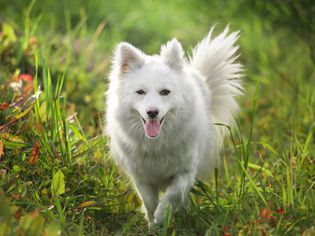
More Dog Breeds and Further Research
If you love the Finnish spitz, you might also like these similar breeds:
- Shiba Inu
- Akita
- Japanese Spitz
There are plenty of dog breeds that can join your family. With a little research, you can find your next best friend!
- Is the Finnish Spitz a Good Family Dog?
With the right training and care, the Finnish spitz can be an ideal family dog. This breed is known for being especially loving towards kids and its adult owners, and it does well with strangers and other animals when properly socialized.
Is a Finnish Spitz a Fox?While they look undeniably similar, the Finnish spitz is a domestic purebred dog. Like the fox, this breed also has a talent for hunting small mammals and birds.
Does the Finnish Spitz Bark?The Finnish spitz is known for barking. These dogs were bred to alert hunters when they found game on the hunt, so it's in their nature to bark to communicate with humans. Your Finkie might need training to discourage barking if it becomes excessive.


